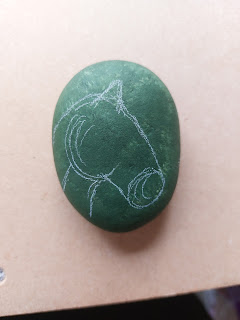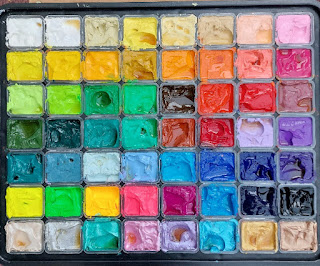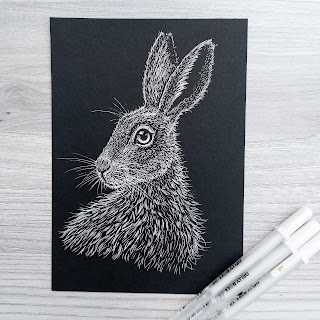Painting animals on rocks - My basic process
Painting on pebbles is something I returned to, accidentally, at Christmas. I'd done a few some years ago and was looking for small projects I could use my acrylic paints on. I buy pebbles from craft suppliers that are designed for painting on because they're considerably smoother than landscaping pebbles that you find in garden centres. It's easier to get fine details on a smooth surface, it also doesn't wear the point on your brush so much, giving them extra longevity.
I start by giving the pebble a wash with some detergent to get rid of any grease, then I paint a thin layer of matte modpodge to give something for the acrylics to grip onto. Each pebble is different so generally when I select one something comes into my mind that would suit it. After stippling on an appropriate background colour, I sketch the basic shapes of what I want to paint in a chalk pencil.For most of my acrylic pieces I use unbleached titanium to block in the basic form and cover the background. At this stage I start refining the shape, or splodge as I call it, into more of the form I want.
On this pony I wanted to get the shape of the nose and mouth right so I started layering in darker colours around the nostril.
I often think of this stage as pushing and pulling the form, gradually making adjustments to get what I want. It's important to remember you need a lot of layers of acrylics so don't get disheartened if it looks a bit streaky early on.
I consider the eyes, nose and mouth to be the most important areas on any animal painting to get right, that's why I usually focus on those first. I get an "aha" moment when it gets a spark of life and I know I'm on the right track. I use a lot of glazes, acrylics thinned with glazing medium so they're transparent, to build up areas that are in shadow. The shadows and highlights give the shapes volume and dimension.
It can be fiddly painting on stones. Not only are they small, the curvature of the surface can be challenging to get the piece to look right. To get the fine whiskers I dilute my paint with airbrush medium. Although acrylics are water soluble, avoid using too much water to thin them, because it weakens the binder and they could lift off with subsequent layers, or with the final varnish.
My favourite bit of the painting is what I call doing the twiddly bits - the eyelashes, mane and whiskers. It just brings the piece to life.
To finish the piece I give it several coats of satin artists varnish. The varnish not only protects the piece from fingerprints, grease, and other things that may over time degrade the paint surface, varnish also brings the piece to life. Particularly satin varnish brings out the depth and luminosity of the paint.









